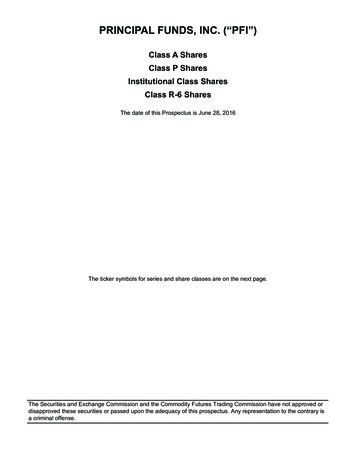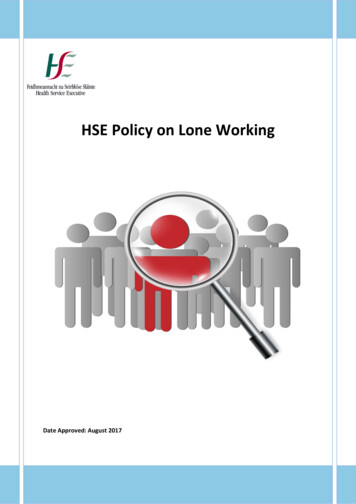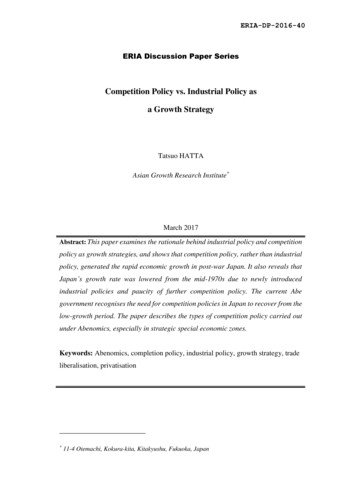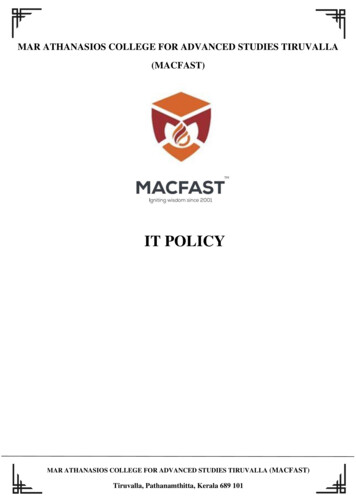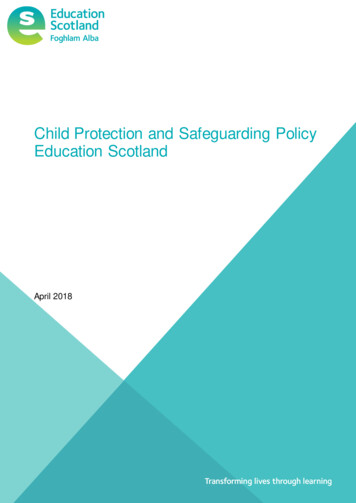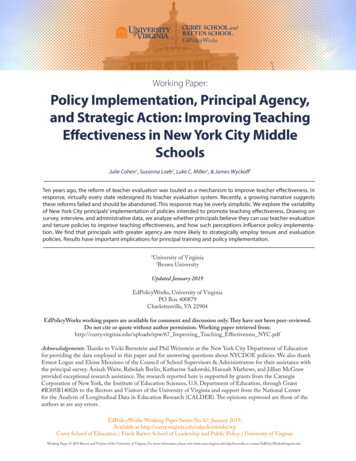
Transcription
Working Paper:Policy Implementation, Principal Agency,and Strategic Action: Improving TeachingEffectiveness in New York City MiddleSchoolsJulie Cohen1, Susanna Loeb2, Luke C. Miller1, & James Wyckoff1Ten years ago, the reform of teacher evaluation was touted as a mechanism to improve teacher effectiveness. Inresponse, virtually every state redesigned its teacher evaluation system. Recently, a growing narrative suggeststhese reforms failed and should be abandoned. This response may be overly simplistic. We explore the variabilityof New York City principals’ implementation of policies intended to promote teaching effectiveness. Drawing onsurvey, interview, and administrative data, we analyze whether principals believe they can use teacher evaluationand tenure policies to improve teaching effectiveness, and how such perceptions influence policy implementation. We find that principals with greater agency are more likely to strategically employ tenure and evaluationpolicies. Results have important implications for principal training and policy implementation.University of Virginia2Brown University1Updated January 2019EdPolicyWorks, University of VirginiaPO Box 400879Charlottesville, VA 22904EdPolicyWorks working papers are available for comment and discussion only. They have not been peer-reviewed.Do not cite or quote without author permission. Working paper retrieved from:http://curry.virginia.edu/uploads/epw/67 Improving Teaching Effectiveness NYC.pdfAcknowledgements: Thanks to Vicki Bernstein and Phil Weinstein at the New York City Department of Educationfor providing the data employed in this paper and for answering questions about NYCDOE policies. We also thankErnest Logan and Eloise Messineo of the Council of School Supervisors & Administrators for their assistance withthe principal survey. Anisah Waite, Rebekah Berlin, Katharine Sadowski, Hannah Mathews, and Jillian McGrawprovided exceptional research assistance. The research reported here is supported by grants from the CarnegieCorporation of New York, the Institute of Education Sciences, U.S. Department of Education, through Grant#R305B140026 to the Rectors and Visitors of the University of Virginia and support from the National Centerfor the Analysis of Longitudinal Data in Education Research (CALDER). The opinions expressed are those of theauthors as are any errors.EdPolicyWorks Working Paper Series No. 67. January 2019.Available at http://curry.virginia.edu/edpolicyworks/wpCurry School of Education Frank Batten School of Leadership and Public Policy University of VirginiaWorking Paper 2019 Rector and Visitors of the University of Virginia. For more information please visit www.curry.virginia.edu/edpolicyworks or contact EdPolicyWorks@virginia.edu
IntroductionResearchers have rightly paid much attention to the role teachers play in altering a varietyof student outcomes, from academic achievement (e.g., Chetty, Friedman, & Rockoff, 2014) toschool engagement (e.g., Liu & Loeb, 2018) to social and emotional skills (e.g., Blazar & Kraft,2017). Policymakers and educators have explored a range of approaches—from professionaldevelopment and coaching programs to financial incentives, teacher evaluation and rigoroustenure standards—to shift teaching practice and consequentially improve student outcomes.While some of these approaches have been successful in pilots or targeted applications, rarelyhave they produced sustained success at scale.Teacher evaluation provides a prominent recent example. Redesigned teacher evaluationwas implemented in most states over the last decade, following a confluence of research (e.g.,Kane & Staiger, 2012) and substantial federal policy incentives (e.g., Race to the Top, TeacherIncentive Fund, NCLB waivers). Some studies show strong positive effects of evaluation policiesin some settings, especially when the policies provide regular feedback to teachers (Dee &Wyckoff, 2015; Papay, Taylor, Tyler, & Laski, 2016; Taylor & Tyler, 2012). However, largescale studies of teacher evaluation and performance pay in New York, Tennessee, and Texas(Fryer, 2013; Marsh, Springer, McCaffrey, Yuan, Epstein, Koppich, Kalra, DiMartino, & Peng,2011; Springer, Ballou, Hamilton, Le, Lockwood, McCaffrey, Pepper, & Stecher, 2010;Springer, Pane, Le, McCaffrey, Burns, Hamilton, & Stecher, 2012; Springer, Swain, &Rodriguez, 2016) show little benefit for students. Moreover, systematic studies of revised teacherevaluation systems demonstrate that in most states nearly all teachers are rated as effective orbetter (Kraft & Gilmour, 2017). This result mirrors teacher evaluation ratings prior to evaluationreform (Weisberg, Sexton, Mulhern, & Keeling, 2009). Taken together, these results have led1
pundits and the popular press to increasingly conclude these systems have failed to improveteaching effectiveness and student outcomes when implemented at scale and given their cost,should be eliminated (Dynarski, 2016; Gates & Gates, 2018; Iasevoli, 2018; NCTQ, 2017;Strauss, 2015).Dismissing policies as ineffective because of inconsistent results may be premature. Arich literature on policy implementation suggests that well-designed policies, successful insmaller pilots, often disappoint when implemented at scale (Fixsen, Naoom, Blase, Friedman, &Wallace, 2005). Recent studies, for example, find that teacher evaluation was not consistentlyimplemented in the ways policies were designed (Donaldson & Woulfin, 2018; Marsh, BushMecenas, Strunk, Lincove, & Huguet, 2017; Stecher, Holtzman, Garet, Hamilton, Engberg, &Steiner, 2018). The reasons underlying failed implemention are varied. A policy that fails toachieve its intended outcome because its design is overly complicated is quite different from onethat fails because school personnel have insufficient resources to implement it reliably, or onewhere policy makers made little effort to encourage school leadership to embrace the approach.Understanding more about reasons underlying implementation can facilitate the design ofpolicies that are more likely to achieve desired outcomes.Policies intended to improve teaching effectiveness are usually designed by states ordistricts but implemented by school leaders. However, school leaders are rarely considered in theteaching effectiveness literature (Goldring & Pasternak, 1994; Grissom, 2011; Harris, Rutledge,Ingle, & Thompson, 2010). The studies that do foreground the role of principals suggest they arecritical actors in policies targeting teacher evaluation and development. Marsh and colleagues(2017) find that school leaders and teachers in New Orleans employing the same teacherevaluation system enacted it quite differently. Some teachers (and schools) were “reflective,”2
embracing the process of teacher evaluation and enhancing it; others were compliant, while stillothers resistant. Donaldson and Woulfin (2018) also highlight the range of principals’ responsesto teacher evaluation policies in Connecticut. Principals vary in their framing of evaluationpolicies—as tools for either accountability or development—and engage in range of“discretionary activities” in implementing these policies. Donaldson and Woulfin (2018) suggestthat discretionary activities, in turn, either enhance or mitigate the likelihood of the Connecticutevaluation policy achieving its intended goals. In a large scale analysis of teacher evaluationacross three school districts and five charter management organizations, Stecher and colleagues(2018) found that principals often do not implement teacher evaluation policies as intended,possibly limiting associated improvements in teaching effectiveness or student outcomes. Takentogether, these studies suggest that policies targeting teaching effectiveness are unlikely torealize their objectives unless principals strategically implement policies in service of such goals.In this paper, we assess the variability of New York City (NYC) principals’implementation of state and district policies intended to promote teaching effectiveness with aparticular focus on principals’ belief in their ability to use policies to improve their teacherworkforce, which we term principal agency. A first step in policy implementation is developingan understanding of the policies and a belief in their potential utility. We survey and interviewmiddle school principals and link that data to rich administrative data to understand whetherprincipals believe they can use teacher evaluation and teacher tenure review policies to improvethe effectiveness of their teachers, and to examine how differences in perceived agency influenceproximal outcomes intended by the policies. Specifically we focus on three research questions:1. To what extent do principals perceive they have agency to influence the teachingeffectiveness in their schools? How does agency vary by the attributes of teachers?2. Does principal agency vary systematically with the attributes of principals and of theschools they lead?3
3. Do principals with high agency use different strategies to implement the policies inservice of their goals?We find that principals vary in their belief in their ability to improve teaching in theirschool. Principals with greater agency are more likely to strategically employ district policiesconcerning tenure review and evaluation, with the articulated goal of improving the teacherworkforce. The results of this study highlight the central role of principals in the implementationof policies targeting teachers, and foreground the importance of principals’ belief in their ownabilities and the usefulness of the policies in achieving state and district policy goals. Withoutbuy in from key policy actors like principals, policies, regardless of their design, are unlikely toactualize necessary changes in teaching.Background and FrameworkAccumulating evidence demonstrates that school leaders matter for school success (seeHallinger & Heck, 1998 and Waters, Marzano, & McNulty, 2003, for reviews). High qualityprincipals consistently predict a range of positive school outcomes, including studentachievement (e.g., Andrews & Soder, 1987; Branch, Hanushek, & Rivkin, 2012; Brewer, 1993;Cheng, 1991; Grissom, Kalogrides, & Loeb, 2015; Goldring & Pasternak, 1994; Leithwood,Jantzi, Silins, & Dart, 1993; Leithwood, 1994), increased teacher satisfaction (Grissom & Loeb,2011), lower teacher turnover rates (Boyd, Grossman, Ing, Lankford, Loeb, & Wyckoff, 2011;Grissom, 2011), and teachers’ commitment to school reform (Yu, Leithwood, & Jantzi, 2002).Exit surveys of teachers find that the single most important factor in teacher retention is theleadership of principals (Boyd et al., 2011; Johnson, Kraft, & Papay, 2012; Ladd, 2011).Strategic management of the school’s teaching force is among the most importantmechanisms by which principals can improve school outcomes (Cohen-Vogel, 2011; Leithwood,Louis, Anderson, & Wahlstrom, 2004; Loeb, Kalogrides, & Béteille, 2012). Effective human4
resource management involves a focus on the composition of the teacher workforce, as well ason the opportunities for capacity building and instructional improvement for teachers in theschools (Cohen-Vogel, Osborne-Lampkin, & Houck, 2013; Grissom, Loeb, & Master, 2013).Many principals, however, struggle to manage the varied responsibilities associated with leadingstrong schools (Grissom & Loeb, 2011).Among their many responsibilities, principals are acknowledged as the instructionalleaders of their schools. Yet we know relatively little about how they use district and statepolicies to attempt to systematically improve teaching effectiveness, or why they make particulardecisions around policy implementation. Some evidence finds that skilled principals encourageless effective teachers to leave if they do not improve, and that some principals employ districtevaluation measures when making these personnel decisions (Grissom, Loeb, & Nakashima,2014; Jacob, 2011). Principals are also differentially skilled at counseling out ineffectiveteachers, another oft-cited strategy for managing the teacher workforce, but little research hasfocused on principal beliefs around strategic retention decisions (Balu, Béteille, & Loeb, 2010;Grissom & Loeb, 2011; Yariv, 2006). Recent research finds that principals differentiallyembrace teacher evaluation policies, which may contribute to uneven implementation of suchpolicies and account for inconsistent effects (Donaldson & Woulfin, 2018; Marsh et al., 2017).Donaldson and Woulfin (2018) suggest more research is needed to understand principals’decision-making processes around teacher-focused policies, and they foreground the importanceof attending to both principal agency and structural or contextual constraints in analyzing policyimplementation.Given the need to improve teaching effectiveness and the central role of principals toachieving that goal, we need to know much more about how principals approach the5
implementation of teacher policies. Do principals use the information provided through thesepolicies to shape their decisions on teacher professional development and teacher retention? Howdo principals’ beliefs about teachers’ ability to improve inform tenure decisions? To what extentdo principals see evaluation systems as actionable formative assessments for all the teachers withwhom they work? Before determining the fate of major policy reforms, such as teacherevaluation, we should understand why such policies may not have realized their expectedpotential to improve outcomes.Schools are complex organizations and many factors influence principals’ efforts toimprove teaching. At the risk of oversimplification, we delineate a conceptual model of theconnections among principals, our focal policies (tenure review and teacher evaluation), andteaching effectiveness (see Figure 1). We focus on the extent to which principals believe theycan improve teaching effectiveness, which we term “principal agency.” Agency is the belief inone’s ability to take action in pursuit of reaching a specific goal (Anagnostopoulos & Rutledge,2007; Coburn, 2016; Donaldson & Woulfin, 2018); in our study, improving teachingeffectiveness or shifting the composition of the teacher workforce. Principal agency is aparticular form of principal self-efficacy, or a principal’s belief in his/her ability to influencevarious processes and effect change in a school (Federici & Skaalvik, 2012; Tschannen-Moran &Gareis, 2004). Prior research suggests that principals with lower levels of self-efficacy struggleto strategize about methods for improving their schools (Tschannen-Moran & Gareis, 2004). Assuch, we theorize that agency may serve as a potentially necessary precondition for strategicengagement with and implementation of the teacher tenure review and the annual teacherevaluation policies. Without a belief that they can improve teaching, we hypothesize thatprincipals are unlikely to use the policies in systematic ways to either shift the composition of6
their teacher workforce or to promote the development of their existing teachers. Strategic policyactions include the ways in which principals report engaging with these policies, including thefrequency of their observations of teachers, the provision of feedback from evaluation and tenurereviews, and their observed strategic retention decisions, including tenure determinations.{Insert Figure 1 here}A large body of literature suggests that both structural and relational features of schoolsinfluence teaching and learning (e.g., Bryk & Schneider, 2002). As such, we posit thatprincipals’ own characteristics and the attributes of their school contexts contribute to theiragency and to the strategic policy actions they employ (Ladson-Billings, 2009; Pacheco, 2009).For example, a more experienced principal working in a smaller school where teachers regularlycollaborate might well feel more agency over improving teaching effectiveness. In contrast, anovice principal working in a large school with a history of animosity between teachers andschool leadership may well feel less agency over teachers. Similarly, a principal’s own skills andexperiences likely influence their differential agency across contexts. Our goal is to build a morenuanced understanding of how the principal’s role in policy implementation processescontributes to outcomes of district policies.New York City Policies around TeachersSituating this research in NYC has several advantages. First, NYC is the largest schooldistrict in the country, with over 1500 schools. It includes some of the most academicallyrigorous schools in the country, as well as some of the lowest performing schools. While NYC isunique in some ways, its diversity provides a rare opportunity to explore principal decisionmaking across a variety of contexts. Second, we are able to link the district’s rich administrativedata on principals, teachers, and students, spanning almost 20 years, to a survey of NYC middle7
school principals and detailed interview data with a subset of principals. The NYC contextaffords us a rare opportunity to connect nuanced principal decision making and strategic actionsto an array of administrative variables about principals, teachers, students, and schools.We ground our exploration of principal agency and strategic action in two districtpolicies that rely heavily on principal discretion and resource management: teacher tenure reviewand annual teacher evaluation. Beginning in 2009-10, NYC changed the tenure review process,infusing more information and increasing the responsibility and accountability of principals toensure that teachers met challenging performance standards. For example, tenure decisions in2009-10 were, for the first time informed by new student learning measures from the TeacherData Reports (which included teacher value-added), in-class assessments aligned with the NewYork State standards, and other evidence of student progress (NYC Department of Education,2009). NYC affords principals the option of approving teachers for tenure, denying tenure, orextending a teacher’s probationary period for an additional year. In 2009-10, the districtencouraged principals to recommend more teachers have their probationary period extended toallow the teachers more time to demonstrate that they met the performance standards appropriatefor tenure.The reform led to many fewer teachers receiving tenure when they were first evaluatedfor tenure; the approval rate decreased from 94% in 2009 to 58% in 2011 (Loeb, Miller, &Wyckoff, 2015). Those not receiving tenure typically had their probationary periods extended anadditional year (increasing from 4% in 2009 to almost 40% in 2011), and “extended” teacherswere much more likely to leave their schools. Schools varied in the prevalence of extendedteachers, potentially indicating substantially differential use of the tenure policy.Since 2012-13, principals in NYC schools have used a system called Advance to annually8
evaluate all teachers on a four-category effectiveness rating scale (Highly Effective, Effective,Developing, and Ineffective) based on classroom observations and measures of student learning.In the 2014-15 school year, the annual evaluation system shifted to a heavier emphasis onformative, ongoing feedback that teachers could use to improve their practice, rather than theprior summative measures. Classroom observations are now mandated at more regular intervals,and each observation is coupled with specific feedback to teachers provided within 15 days ofthe observation. While no research of which we are aware has analyzed variation in theimplementation of Advance, we theorize that principals’ agency is associated with theirassessment of the evaluation system’s usefulness and the strategies they employ to implement it.NYC’s teacher tenure review process and annual teacher evaluation system are designedto infuse more and higher-quality information into principals’ decision-making processes. Thesepolicies also provide mechanisms by which teachers receive guidance on their weaknesses andbenchmark their progress addressing those weaknesses. Do principals perceive their abilities toinfluence teaching effectiveness differently? If so, are these differences associated with theirdifferential use of these policies? Our analysis addresses these questions which we believe haveimportant implications for understanding the effects of these policies.Data, Measures, & MethodsOur goal is to understand how principals vary in their agency to improve teachingeffectiveness, how agency differs across schools, and whether agency is associated with differentapproaches to policy implementation. This requires access to data not typically collected bydistricts. We, therefore, augment rich administrative data on principals, teachers, students, andschools with two primary data sources: a survey of principals, which focuses on their perceptionof their agency over teaching effectiveness, and in-depth interviews of a subset of principals that9
explore these issues in more detail. Taken together, these different measures provide differentinsights into principal agency and policy implementation from both self-reports and observedactions, affording a more fulsome discussion of our research questions.DataPrincipal Survey. Our principal survey had two goals. First, we sought to measureprincipals’ sense of their ability to improve teaching effectiveness in their school throughdeveloping teachers and/or compositional change (retaining effective teachers and attritingineffective teachers). Second, we wanted to understand principal attitudes toward key teacherpolicies, and how principals were implementing these. We administered the survey online in theSpring and Summer of 2016 to principals in all NYC schools serving grades 6, 7, or 8 (n 494).A copy of the survey is found in Appendix A. As an incentive for completing the survey, wegave a 50 gift card to each principal’s school. A total of 258 completed surveys were returnedfor a 52% response rate. Table 1 presents characteristics of the middle schools in the surveysample and the full population.{Insert Table 1 here}Principal Interviews. The surveys provided information about both principal agency andthe strategies employed around policy implementation from a broad and representative group ofmiddle school principals. To provide greater nuance about how and why principals madeparticular decisions around policies, we emailed all the principals who completed the survey andinvited them to participate in an additional interview, with an incentive of 100 gift card for theirschool. Our volunteer interview sample included 45 middle school principals, approximately19% of the survey sample. This was a convenience sample, and the group of principals weinterviewed is not wholly representative of either the survey sample or the total population of10
NYC middle school principals (see Table 1). That said, these interviews provide invaluablenuanced insight into how principals thought about policies designed to improve teaching.Principals spoke at length about challenges of working with different populations of teachers andthe degree to which policies supported or hindered their efforts at improving teaching.We conducted all interviews over video-conference, and each interview lasted betweenone hour and two and a half hours, depending on the level of detail provided by the participatingprincipals. One of the authors, a postdoctoral fellow, and three doctoral students conducted allinterviews using a semi-structured interview protocol focused on understanding why and howprincipals made decisions regarding policy implementation. At the conclusion of each interview,interviewers member-checked notes with each interviewee to insure our interpretation matchedthe interviewee’s interpretation (Creswell & Miller, 2000). A professional transcription servicetranscribed all recorded interviews.Administrative Records. The administrative data files we obtained from the NYCDepartment of Education (NYCDOE) and the New York State Education Department allow us toplace principal responses to the survey and interview questions in context. First, the NYCDOEemployment records, available from the 1990s to 2016, allow us to observe the work histories ofall principals and teachers. Second, the Tenure Notification System files capture all NYCDOEtenure decisions made between 2008 and 2015. Third, the NYCDOE student demographic andassessment files, available from 1999 to 2016, provide us with information on all students in allNYCDOE schools. Fourth, the teacher-student linkage files allow us to match students to ELAand math teachers between 1999 and 2016. Finally, the State’s annual School Report Carddatabase and Institution Master Files together with the National Center for Education Statistics’Common Core of Data files provide characteristics of each school.11
MeasuresAgency. Our measures of principal agency make use of two sets of survey questionswhich ask the principals to indicate their capacity to increase the overall effectiveness of theteacher workforce at their school (1) by developing individual teachers and (2) by changingwhich teachers are in the school. Both questions ask about four groups of teachers: pre-tenureand post-tenure teachers who are either below expectations or meeting or exceeding expectations(see survey questions 3 and 4 in Appendix A). Principal responses to these questions characterizeagency along two distinct dimensions: the tenure status of the teachers (pre-tenure versus posttenure) and the performance of the teachers (performance below versus meeting or exceedingexpectations).In creating the agency measures, we sought to discriminate between low and highagency principals. We calculated two statistics: (1) the percent of questions with a low-agencyresponse (“Not at All” or “Some”) to the relevant questions and (2) the percent of questions witha high-agency response (“A Lot”).1 We label a principal as low-agency if he/she provided a lowagency response to at least 75% of the relevant agency survey questions. Similarly, we label aprincipal “high agency” if he/she provided a high-agency response to at least 75% of the relevantquestions. The remaining principals are assigned to the medium agency category.Strategic Actions. We examine six measures of principal strategic actions for the tenurereview process and six measures for the Advance teacher development and evaluation system.All these measures are taken from the principal survey with the exception of information on thenumber of tenure decisions resulting in a teacher’s probationary period being extended, which iscalculated from administrative data. We list each of these measures in Table 2 and providedescriptive statistics for them in Table B1 in Appendix B.12
{Insert Table 2 here}Principal Attributes and School Context. In linking the surveys to the administrativedata, we create measures of the context in which principals work as well as their demographicsand professional experience. We observe each principal’s gender, race/ethnicity, age, years ofexperience as the principal at the current school, and whether the principal had previously been ateacher at the school. We characterize each principal’s working context with a series of school-,teacher-, and student-level measures. While all schools serve the 6th, 7th, or 8th grades, someschools also serve grades below 6th and/or grades above 8th. We characterize the teacherworkforce with which the principal works with average years of teaching experience at thecurrent school, the percent who are on probationary status (do not have tenure), and two valueadded measures of teacher performance (the percent of teachers with an ELA value-added scorein the bottom quarter of the district-wide distribution and the same for mathematics value-addedscore).2 Finally, we capture the characteristics of students at each principal’s school by variablesthat measure the total student enrollment, the racial/ethnic composition of the student body, thepercent eligible for free/reduced-price lunch eligible, and their performance on the statewideassessments in mathematics and ELA. Table 1 provides descriptive statistics.MethodsTo answer our three research questions, we employ a variety of descriptive analytictechniques to the survey and administrative data, which we detail below. We augment theseanalyses with insights gained from the analysis of the principal interviews so as to furtherelucidate the relationships among the constructs presented in our conceptual framework (Figure1).13
Principal Survey. We begin by developing an understanding of how principal agencyvaries (RQ1) and whether contextual factors may explain that variation (RQ2). We examine thedistribution of the four agency measures and assess the degree to which they are correlated.Drawing on survey data, we estimate a series of ordered logistic regression models to assess howprincipal and school characteristics are related to high-agency (RQ2):(1)𝐴𝑔𝑒𝑛𝑐𝑦' 𝛽 α, 𝑃𝑟𝑖𝑛' γ, 𝑆𝑐ℎ𝑙' θ, 𝑆𝑡𝑑𝑡' λ, 𝑇𝑐ℎ𝑟'Equation 1 predicts the degree of agency a principal has as a function of vectors of principal(𝑃𝑟𝑖𝑛' ), school (𝑆𝑐ℎ𝑙' ), student (𝑆𝑡𝑑𝑡' ), and teacher (𝑇𝑐ℎ𝑟' ) characteristics. We estimate thismodel for all agency measures.Shifting to how principal agency is correlated with their strategic actions to implementteacher policies (RQ3), we estimate regressions similar to those specified in equation 2 wherewe predict a strategic action as a function of a principal agency measure, principalcharacteristics, and the school context.(2)𝐴𝑐𝑡𝑖𝑜𝑛' 𝛽 𝛿; 𝐿𝑜𝑤' 𝛿 𝐻𝑖𝑔ℎ' α, 𝑃𝑟𝑖𝑛' γ, 𝑆𝑐ℎ𝑙' θ, 𝑆𝑡𝑑𝑡' λ, 𝑇𝑐ℎ𝑟'In these models, the coefficients of key interest are those for the indicators for low and highagency (𝛿; and 𝛿 , respectively) which both measure differences in strategic actions relative tomedium agency principals. We conduct a
of New York City principals' implementation of policies intended to promote teaching effectiveness. Drawing on survey, interview, and administrative data, we analyze whether principals believe they can use teacher evaluation and tenure policies to improve teaching effectiveness, and how such perceptions influence policy implementa-tion.
